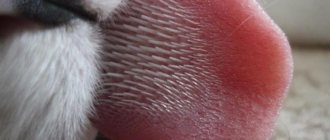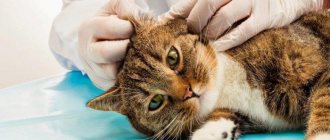When a pet gets sick, its owner falls into a real panic. This is not surprising, because the animal cannot tell what exactly hurts it and how it feels. Based on this, owners of four-legged animals have to search for information on the Internet on their own, studying similar cases, or contacting a specialist in this field.
Sometimes people are interested in the fact that the cat has a bump under its tail. Could this be a symptom of a serious illness or is it nothing to worry about?
Basically, the appearance of seals on the tail is explained by the fact that the animal may have received insufficient care, and its nutrition is not balanced. However, there are other reasons.
Bruises and injuries
If the animal often walks on the street, then a fight could easily occur between several cats. They become especially aggressive at the beginning of spring, as their most romantic period begins. Damage can also occur at the household level. For example, an animal climbed onto a cabinet and fell unsuccessfully. Sometimes pets are injured by their owners, but only through their own negligence.
If damage to the skin occurs, then an infection could enter the body in this place. This often results in abscesses that look like the cat has a lump at the base of its tail. Such a manifestation requires mandatory examination by a doctor.
Signs of development of perianal gland adenoma in cats
Here are the main signs of the development of adenoma of the perianal glands:
- The appearance of tumor-like formations around the pet's anus.
- If the process of adenoma formation is accompanied by inflammatory processes in the thickness of the organ, ulcerations may occur, and tumors may bleed.
- Many cases are characterized by severe itching. At the same time, the cat constantly licks the anal area, which only intensifies the inflammation.
- Problems with defecation, since the tumor at the base of the cat’s tail strongly compresses the anus and even the final segment of the rectum. If the cat’s sinuses are inflamed, then every trip “largely” turns into real torture for the animal. Because of this, severe constipation develops, accompanied by severe autointoxication.
Important! If the adenoma “mutates” into adenocarcinoma (i.e., turns into a malignant tumor), the animal in many cases begins to drink much more, and the daily volume of urine increases sharply. It should be taken into account that in this case, metastases may already be in other organs, and therefore other signs may be added to the symptoms described above.
Demodicosis
This is a fairly common reason for the appearance of a bump on a cat’s tail, which occurs in veterinary practice mainly in the warm season. In this case, we are talking about infecting a four-legged pet with a subcutaneous parasite, which is known to many as a tick.
But some people don’t even realize that it not only begins to suck blood from a helpless animal, but also leads to the development of extremely serious infectious pathologies. A tick can parasitize a cat’s body for quite a long time. Most often, pets who are allowed to walk outside suffer from this pathology. However, a person can also bring ticks on clothes into an apartment.
Ligament rupture
In cats, ligament rupture is possible. They are dense, fibrous tissue that envelops the joints. Ligaments are more likely to tear in a cat's limbs, but the problem can occur in the spine and tail.
This can happen due to injury or birth defects. A torn ligament causes severe pain in the tail.
The diagnosis can be confirmed using an x-ray. Treatment can last about a year. You will need to wear a special fixation bandage.
Cancer
Unfortunately, cancer can cause a lump to appear on a cat's tail. In this case, it is necessary to conduct a serious medical examination. Depending on the final diagnosis, appropriate treatment will be prescribed. In some situations, at the initial stage of oncology development, it is possible to fight this disease and achieve a complete cure for the animal.
However, it is very important not to delay the treatment process.
Causes of tumors under the tail in cats
Let's consider the main causes of tumors under the tail in cats, most often encountered by practicing veterinarians.
- Inflammation of the perianal (paraanal) glands , also called sinuses.
- Development of an adenoma (benign tumor) of the same sinuses.
- Abscess. This is a specific place, the skin can easily become stained with feces, and if there are scratches or abrasions on it, the wounds will probably become inflamed.
- Malignant tumors (i.e. the animal develops cancer of the perianal sinuses).
Main symptoms
If a lump appears on a cat’s tail, then you need to clarify the reasons for this formation. To do this, you need to pay attention not only to the behavior of the animal, but also to the characteristics of the neoplasm itself. If the lump is soft, then in this case it is most likely to be an abscess. This is a dangerous condition.
If a cat has purulent bumps on its tail, then the animal will additionally experience an increased body temperature. Abscesses can be either only on the tail, or throughout the body. In this case, the animal will behave very restless and irritated. Especially when its owner presses on a sore spot. If a cat has a lump on its tail or other alarming signs are observed, then measures need to be taken.
If the formation is solid, then most likely it is a healed fracture of the tail bones. However, such manifestations may also indicate more serious pathologies.
If the animal suffers from the parasitic activity of a tick, then in this case it will immediately experience a number of alarming symptoms. Among them, it is worth highlighting increased body temperature, lethargy, constant apathy, lack of appetite, paleness of the mucous membranes of the eyes and mouth. It will become more difficult for the animal to move, and shortness of breath will appear.
If suspicions fall on a wen or lipoma, then, as a rule, such formations do not manifest themselves at all and remain completely invisible to the animal. The cat will allow itself to be stroked, and at the moment of touching a troublesome place, do not be nervous. As a rule, wen forms if the pet has a metabolic disorder.
Oncological pathologies are the most difficult to manifest. Cancer can remain invisible for a long time both to the owner of the four-legged pet and to himself. To identify this pathology at the very initial stage, it is necessary to periodically conduct a full medical examination of the pet.
Symptoms of benign and malignant tumors
In order to contact a veterinarian in time, you need to know the symptoms of benign and malignant tumors.
With benign neoplasms everything is quite simple:
- Tumors of this type are quite soft; upon palpation, their elastic, dough-like consistency is felt.
- You can always see where the tumor is and where the healthy tissue is, i.e. the boundaries of the neoplasm and surrounding tissues are visible very clearly; the tumor does not merge or grow together with them.
- Hair grows on a benign tumor; there are no hairless, flaky areas on it.
- New growths usually do not tend to ulcerate, they do not bleed or hurt. However, the adenoma we are describing may well be an exception: if the organ is inflamed and a tumor is growing in it at the same time, a painful reaction will certainly occur.
- Slow growth (over several months, or even years).
Accordingly, malignant neoplasms can manifest themselves from the completely opposite side:
- They often hurt or cause other unpleasant sensations, causing the animal to constantly lick or even “gnaw” at the site of the tumor (which can lead to bleeding and tissue infection).
- Oncological tumors often bleed, ulcerations, cracks, strange-looking sores, etc. form on their surface.
- Hair does not grow on the surface of the malignant tumor.
- The boundaries between healthy tissue and neoplasm are blurred, as the tumor literally grows through them.
- The “indicative” symptom is the growth rate. It is impressive in malignant neoplasms: the tumor can increase in size almost before our eyes.
Features of treatment
Therapeutic measures are prescribed by the doctor depending on the specific cause that led to the appearance of a bump on the cat’s tail. To do this, you first need to undergo diagnostics and tests.
If we are talking about a purulent abscess or an early stage of cancer, then in this case the intervention of a surgeon is usually required. When a tick or wen appears on an animal’s body, surgery is not always performed. The doctor must take into account the risks depending on the age of the animal and its state of health.
If the lump appears due to a broken bone, then in this case it needs to be cleaned. This procedure is also performed by a specialist. After this, the treated area will need to be periodically lubricated with antibacterial and healing agents prescribed by the doctor. Also, after treatment, you need to give the animal rest and adjust its menu.
Preventive measures
To keep the animal healthy, it is necessary to regularly carry out preventive procedures. Only quality foods such as Eukanuba, Go Natural or Now Fresh should be fed. You should not feed your pet the same food you eat yourself. It is important to use only natural products and follow a specific diet. If, in addition to pain, diarrhea occurs, then you should give the cat a decoction of herbs (for example, chamomile). Twice a year for a month, the cat must be given vitamins, regardless of diet and health status.
If a cat screams when you touch its tail, then the cause may be either hereditary abnormalities or diseases. First of all, you should take the animal to a doctor, because in most cases, the resulting painful sensations can cause irreparable harm to the cat. You will only relieve pain and reduce symptoms on your own, but the full course of treatment must be prescribed by a doctor.
Prevention
In order not to guess why a cat has a bump on its tail or any other formations, it is best not to let the animal go outside unnecessarily, especially in the spring. If this is not possible, and the pet still goes for walks periodically, then in this case it is recommended to purchase a special collar, the smell of which will drive away parasites.
To exclude most other problems, you need to review the animal’s diet and balance it so that the cat receives all the necessary mineral components and vitamins. However, allowing obesity is also not recommended.
Sometimes bumps of this type are congenital. They become noticeable immediately after the kitten is born. In this case, the defect does not affect the condition of the animal in any way, so there is no cause for concern. But it’s better to play it safe and rule out other pathologies.
Approximate treatment regimen for adenomas and inflammation of the paraanal sinuses
The specific treatment regimen directly depends on the root cause of the tumor. First, let's look at the treatment method for “purebred” adenomas that are not complicated by inflammation of the sinuses:
- If a cat is sick and the tumor is already large enough, castration is strongly recommended. Practice shows that tumors often resolve spontaneously after removal of the testes and a decrease in the level of male sex hormones in the blood.
- If an adenoma appears in a cat (especially of fertile age), it must be removed, since in females such neoplasms tend to undergo malignant degeneration.
- Conventional surgical excision of the tumor is usually practiced, but in some clinics (suitably equipped) they resort to radiotherapy. It allows you to “gently” remove the tumor, and in some cases you can do without castrating the animal.
The Scottish Fold cat has a kinked tail.
What ordinary people call a crease is not always the correct word. Veterinarians identify tail abnormalities that can be confused with a kink: kink and bend. We will not go into a description of each type, because... This won't mean much to the average person. But look at the picture.
It is difficult for the owner to determine the type of anomaly by touch and visually; this can only be said for sure after an x-ray.
Most likely, with such a deformation we are dealing with a congenital anatomical defect. In this case, the veterinarian takes an x-ray of the entire spine. You may also need x-rays of your extremities. Only after this and a number of other studies is a diagnosis made.
If the problem is limited to the tail, then a similar anomaly occurs in all breeds, not just Scottish cats. And it can manifest itself in both folds and straights.
Where do such deformations come from? The first possible cause is trauma, or rather dislocation of one of the caudal vertebrae. Then the deformity is eliminated with a slight movement of the veterinarian’s hand: the vertebrae fall into place.
But more often the cause of the deformity is a congenital anomaly in the structure of the vertebrae, which occurs in the embryo at the beginning of pregnancy. This may be a hereditarily transmitted anomaly, or it may be a mutation that occurs by chance. It is facilitated by viral diseases of a pregnant cat and the use of certain medications during pregnancy.
In many cases, such a mutation is only one of the problems: as experience shows, tail abnormalities are often accompanied by abnormalities in the development of the heart, kidneys and genitals. This is why it is so important to conduct a full examination of the animal if problems with the tail are identified. Moreover, these deviations may not appear at the same time, so the cat will have to be examined regularly for preventive purposes.
Cats and tomcats with abnormalities in the structure of the tail, with rare exceptions, are removed from breeding so that they do not give birth to sick offspring. This is done because, even if the parents have no other problems other than a “broken” tail, they will pass the anomaly on to their children - and in them it will be associated with diseases of the entire musculoskeletal system and internal organs.











